#Zend Developer
Explore tagged Tumblr posts
Text
Hire Zend Developers
Partner with YES IT Labs and hire Zend Developers to craft scalable, secure, and tailored solutions. Revolutionize your web presence with expert Zend apps.

0 notes
Text
Utilize Comprehensive Tech Capabilities of Zend Programmers for Effective Business Web Solutions
Zend web development is a popular, fast, and easy-to-learn framework that is becoming a favorite in the market. This is why businesses need someone with a thorough knowledge of coding, data encryption, URI routing and a high degree of precision so they can make a successful usage of Zend framework for website development.
However, finding the qualified and expert Zend PHP developer with a very intact knowledge of Zend framework and MVC architecture traditionally can be difficult. With advancement in the tech sector, the need for talented resources is also getting skyrocketed. Therefore, most businesses are opening doors for Zend development outsourcing.
If you also want to hire Zend programmers for your custom projects, outsourcing is the answer. Outsourcing lets you look for the programmers who can capitalize on the scalable, comprehensive, secure, and robust attributes of Zend framework for your project.
Whether you decide to sign a bond with a Zend development company in India or abroad, you will get an experienced team of developers dedicated to developing, integrating, and designing Zend framework applications.
Collaborating with the outsourcing Zend companies will not only save money, provide time-bound delivery, but also ensure that your data is secure with encryption.
The offshore professionals with years of experience understand the ethical standards of working and use their skills like attention to detail, problem-solving, excellent communication, and technical mindset to make your projects a success. They are also well-versed with the confidentiality of client-vendor relations and work accordingly.
Hence, deciding to hire Zend programmer will help you transform your ideas into reality really quickly.
0 notes
Text

At Arihant webtech, we pride ourselves on being a leading Zend Framework development agency dedicated to crafting bespoke web solutions that drive business success. Our team of skilled developers and technology experts leverage the robust capabilities of Zend Framework to build scalable, high-performance web applications tailored to meet your unique needs.
0 notes
Text
How to Fix “Class Zend Not Found” Issue in Magento 2

Hey there! Guess what? On March 14, 2023, Adobe launched Magento 2.4.6, and it was super exciting! This update came with over 300 quality fixes and awesome platform improvements. We were all looking forward to these positive changes, but there was one thing we didn’t expect: a big change that might cause some issues for those who upgraded. You see, Adobe decided to say goodbye to the Zend framework, and because of that, some users started facing a problem called “Class Zend Not Found” after upgrading to Magento 2.4.6. But worry not! In this blog post, I’ll walk you through the simple steps to fix this problem and make sure your Magento 2 store runs smoothly. Let’s get started!
Reasons for the “Class Zend Not Found” Error
The primary reason behind the “Class Zend Not Found” error in Magento 2.4.6 is Adobe’s choice to phase out the Zend framework from Magento’s codebase. Instead, they opted to replace it with Laminas, which is a fork of the Zend framework.
The switch from Zend to Laminas was made to take advantage of the progress and enhancements provided by the Laminas project. Laminas offers a more resilient and contemporary framework for PHP development, prompting the decision to transition.
Nevertheless, this shift implies that custom code, third-party modules, or extensions dependent on Zend classes might not work with Magento 2.4.6 anymore. The absence of the Zend framework could trigger the “Class Zend Not Found” error when the system tries to create or use Zend classes that have been substituted with their Laminas counterparts.
To fix this error, it’s essential to modify the affected codebase, including custom code and third-party modules, by replacing deprecated Zend classes with their corresponding Laminas counterparts. Alternatively, although not recommended, you can temporarily resolve the issue by re-adding the Zend framework to Magento.
Common Messages When Facing the “Class Zend Not Found” Error
Error: Class “Zend_Json” not found.
Error: Class “Zend_Http_Client” not found.
Error: Class “Zend_Validate” not found.
Error: Class “Zend_Filter” not found.
These typical error messages assist in pinpointing the specific Zend classes responsible for the “Class Zend Not Found” error. It is vital to update the codebase to utilize the relevant Laminas classes or, if possible, consider reintegrating the Zend framework. More Info: https://www.evrig.com/blog/how-to-fix-class-zend-not-found-issue-in-magento-2/
0 notes
Text
Zending

Lore and doodle below. (TW: suicide)
Nar hates when people he truly cares about get hurt. He’s terrified of losing those he cares about, especially if it’s because of something he’s done.
The Zending breaks him and makes him stop talking for a few resets because of the guilt. Did he push Stanley to do that out of desperation? Would Stanley be better off without him?
After a while, he’ll finally speak up again, but be much less harsh and quieter.

This, of course, is only when he feels that Stanley is a person and not a character to be puppeted. Towards the beginning of his job Nar wouldn’t care as much, because Stanley hasn’t become as human.
Sorry if things don’t make sense, I’m getting back into developing and writing my AU lore haha 😅
#tsp#the stanley parable#tspud#oc#tsp narrator#tsp au#my art#unwanted guest au#tsp unwanted guest au#artists on tumblr#tsp Stanley#tsp zending
244 notes
·
View notes
Text
The use of color in The Stanley Parable: HD and Ultra Deluxe (with honorable mentions to the Demo)
dedicated to @squuote who needs more TSP analysis to rotate
A little over a year ago, I (only somewhat jokingly) lay out the argument that while The Stanley Parable is notorious in its use of yellow, the color yellow is not actually associated to the Narrator. The color most associated with him, I argued, was red. [1, 2]
I've had plenty of thoughts regarding color and TSP in the interim and I want to go over those thoughts today in as much depth as I can manage. You know, for fun. None of this is to argue about creator intent, but it's a fun way to stretch the critical thinking and literary analysis portions of my brain. It's also super cool if you don't agree with my readings, since the point is to get you thinking about these things and studying them to interpret for yourself.
Anyway let's gooooooo
(note: all images are embedded with a link to the source page I pulled them from. For those on mobile, be careful with your scrolling and tapping!)
Yellow
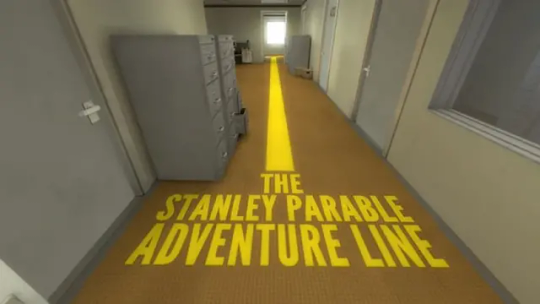
Okay let's start with the “obvious” one. Yellow is seen as one of the main colors in the game, it's the color of the main office and the primary assets associated with the Parable. We see yellow PRIMARILY in the beginning of the office, before the two doors room. It lines the cubicles and the walls are often interpreted as yellow (eh, they're more of an off-white. They're actually absorbing color from the brown-yellow carpet, and they do the same in the lounge).
It's the color of the Line(TM), it's the color of the cargo lift in the warehouse, and, most strikingly, it's the color of the SKIP Button.
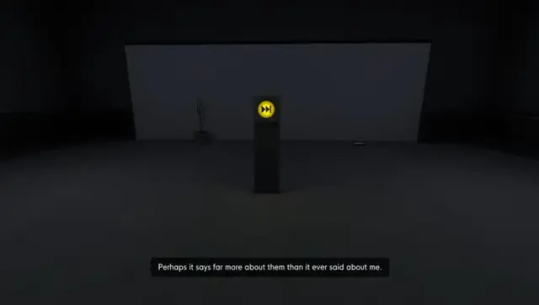
We'll get to you.
Okay, so yellow is a color with conflicting interpretations, which is par for the course for all of them, we're not going TOO insane on color theory and color psychology we will be here ALL DAY and I was an ART student. So let's just look at the most basic reading. Bright, oversaturated yellow is a color that can exhaust the eyes easily. It grabs our attention like a highlighter and burns our retinas.
It can be a color of excitement, but it can also be a color of sickness. I've been thinking about the short story The Yellow Wallpaper the past couple days. Or maybe I've been thinking about it for longer. It's just that I haven't reread it in actual years, but every time I saw someone talk about the wallpaper in TSP, I thought about the story. Here's some passing thoughts on the short story in comparison to TSP. [3]
Sickness, and madness, and beginnings, and infinity. In the end, yellow, to me, is the color of the Parable grabbing the player (and by extension the Narrator) by the nose and saying “let's get moving. We have a story to play. Play the game, and keep playing.” Notable to me is how the SKIP button is almost scathingly yellow in contrast to the room it's in, and as the room gets darker the glow gets more foreboding. The Parable did this. The Narrator might think he made it, but he doesn't control it. Yellow isn't his color, and it never was.
Red
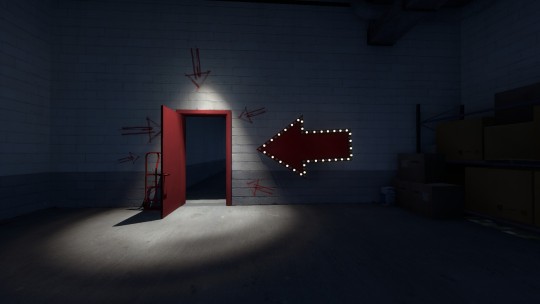
“Stanley walked through the RED. DOOR.”
The use of red in TSP is probably the most interesting and fun to analyze for me. It's used extremely intentionally and it's commonly associated with power, anger, and passion. We see red in the Boss's Office, in the Countdown ending, as the door to the Starry Dome, and a TON in the TSP2 Expo. There's red doors and signs in the Escape Pod Bay.
So I've joked that the color red is the Narrator's color, and while it's still a fun interpretation, it's not one I'm married to. I think it's more accurate to say red symbolizes control. The Zending Door is you letting him control the story. The Countdown screens are him taking control from you. And TSP2 is the Narrator trying to exert control over what the developers have made. It's a response to New Content and to the SKIP button. I have a million trillion thoughts about the TSP2 Expo but I won't get into them here.
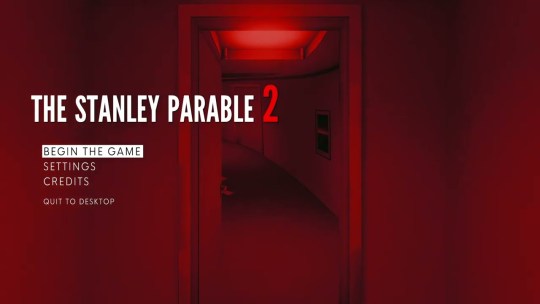
Anyway, red feels very obviously to me associated with the Narrator trying to take control, or things only being possible when he has control. I'm thinking about the signs in the Escape Pod Bay telling you that it won't work without him. (I'm thinking about how the same door asset for the Zending is used in the Escape Pod Bay. No. shhh. Staying on topic.) So I don't have much more to say on the matter because I feel like I've tread this ground before. Red is about control, and it is held in direct contrast with blue.
Blue

Oh, blue. Soothing blue, sweet relaxing lounge and ocean paintings and boss's bathroom and blue door that leads to broken textures and an irritable Voice.
If red is the color of control, then blue is the color of rebellion. Small rebellion, sure. Rebellion that means nothing in the scheme of things. Blue is the stepping stone to bigger deviations from the path. I mean, the lounge is only the first step to the right, and you can still get on the “correct” path. The blue door you have to go through repeatedly, you have to make the choice multiple times, for it to lead to the Games ending. The boss's bathroom doesn't GO anywhere until after the epilogue. These are “rebellious choices” in a game where you don't really have a choice, and it's the closest you get to defiance.

I like to make it Stanley's favorite color for obvious reasons.
(Hey, fandom, why you keep associating it with the Curator? The only blue in the Museum is in a couple assets on display.)
Green
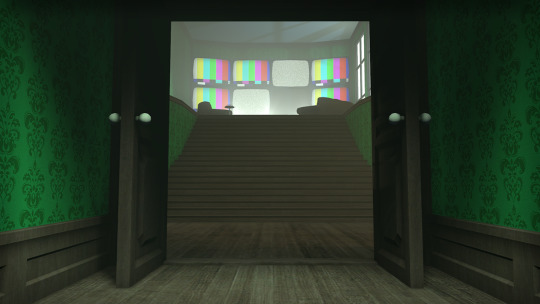
I gotta admit, while there's definitely something to green and its use in TSP, a clear meaning for it is eluding me, and I've been thinking about it on and off for a couple days now. It's a fairly infrequent color in TSP as a whole, but it does make an appearance. Besides being the color of plants (such as the ever important fern, the potted plants scattered through the office and the ones in the TSP2 expo, and of course the growth in the SKIP button room), it's also the wallpaper in the Demo, and the same wallpaper is used in the Boss's Office in the Real Person Ending. Thinking further, it also appears in the small room before the stage in the Press Conference Ending, and it's the color of the carpet in the HL2 Office that is found under the Games ending. (It was also brought up by my pal glitch that green is the color of the cursor on Stanley's screen, the first thing you see before gameplay begins. Good catch!)
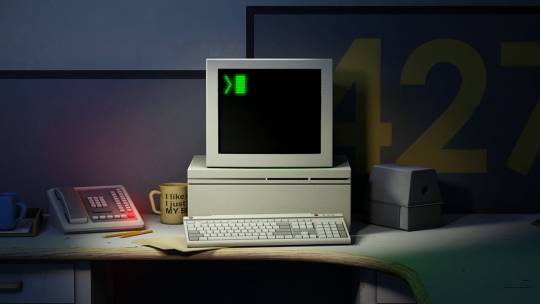
Thinking about it, it's hard to find a throughline. There's something familiar about the green. Not necessarily safe, but it usually comes before something much bigger. Maybe this is a bit of a stretch, though. Let's say for now green is associated with the familiar in the face of the unfamiliar.
(There's possibly a thesis here about green being associated with gifts and surprises. The Narrator makes the Press Conference ending something that teases but also praises Stanley, the Green Room in the Demo is the space where the Demo is meant to be revealed to you, and that alternate Boss's Office is supposed to, in the Narrator's mind, be the first step to a wonderful story made just for you.)
White

Most people, when they think of white in The Stanley Parable, immediately think of the Museum. And they're right to! It's one of the most prominent environments that uses white. With that in mind, we can't forget the other places it appears, since it's best to keep everything in mind when trying to formulate a meaning for it.
So, other places where white is prominent: We have the out-of-bounds ending, and the Art ending (aka play that Baby game for four hours). We also have a massive part of the TSP2 expo.
Honestly, there is a lot of white in the rest of the office, but it tends to be absorbing the colors of the environment in ways that make it less noticeable. White's really good at that, which means the times where it's by itself as the outstanding color are outliers and feel intentional. So what do these things have in common?

Well, they kind of show the seams of the game? Take this with a grain of salt, but the Museum is designed to show you some of the design process for the game, effectively taking you out of the setting to give you a top-down perspective (hehe, literally in the case of the diorama of the office up to the two doors), and the out-of-bounds ending is a joke about breaking the map, falling out of the world , which can break immersion in other games. The TSP2 Expo is the Narrator showing off all the features for his sequel idea, giving a “sneak peek” of what will be included.
The Art ending doesn't fit with this thesis, but it does involve the... revelation, I suppose, of the “character” of the Essence of Divine Art. What I'm trying to get to is that white is a color of revelation and display.
Gray
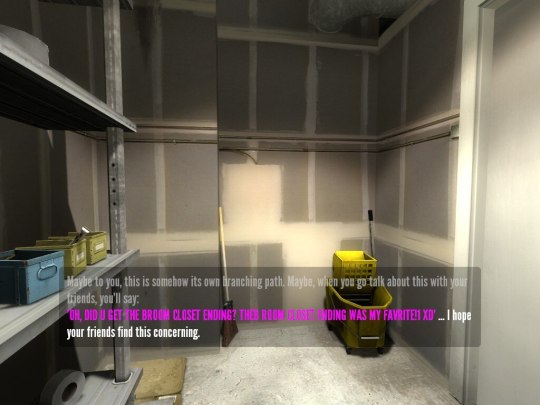
Gray is not a color that tends to stand on its own merit in The Stanley Parable, and that in itself is intentional. Gray is used as a texture of “unfinished” things, things the Narrator doesn't want you to look closely at, and would prefer you move past Right Now Right This Second Please.

It's the walls of the Broom Closet, as well as the walls of the maintenance room. It's also the walls of the room right outside the Starry Dome—the hall that leads right to the stairs. (Honorable mention, @chirpbudgie brought up that the desks in the office are gray, which is also an implication of the way Stanley's coworkers seemed to disappear with work unfinished. There is a sense of “wrongness” in how they've all vanished. Nice eye, bud.)
You're not supposed to dwell in these places. Go back to the story, please!
Black
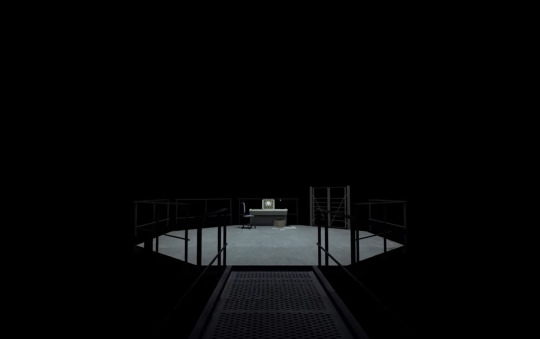
“Blackness, and a rising chill of uncertainty. Was it over?”
Last and least is black, less used as a color in its own right and more a use of shadow. It really stars primarily in the Mind Control Facility, dark rooms with a sense of foreboding. Honestly, what is there to say about black?
Only, I tell a lie. You see quite a lot of black in this game, don't you? After all:

It's the Loading screen.
Blackness is uncertainty, and mystery, like the game tells us, because anything could be hiding in the darkness, and anything could happen when that screen is finished loading. It's white's opposite not just in value but in meaning. You don't know what's going on, you just have to wait and see. Any time you might have an answer, or an ending, here comes that loading screen to wipe the slate clean and say “hey, what haven't you found yet? What haven't you tried? What tricks does this game still have up its sleeve?”
(And now I'm thinking about the Figurines ending, and how the Narrator shouts to stop the loading screen, to go back and stay in the familiar please!! Because the fellow hates uncertainty, really he does. But that's a thesis for another day.)
(We also can't forget that Ultra Deluxe's Setting the Time is also set on a black background, and there's always, to me, a sense of foreboding and uncertainty there too. What happens after this is the game, right? Is this for something? Is this doing anything? Is it changing anything?)
Silver

It's a bucket :)
Okay that's the end of this post. There's probably plenty more to say about this subject, this isn't exhaustive by any means. Color is an incredible tool, and visual storytelling and color interpretation is not in any way a science. As I posted bits of this in my server for extra feedback and examples of color, other folks brought up an entirely different interpretation of the color green. And I didn't even bring up Mariella being dressed in full green!
Anyway I didn't bring up orange because there's only a couple instances of it in the game but its always about unfinished things/assets (Baby game, just a lot of Games ending things) but it also shows up in the TSP2 Expo (Button That Says The Name of the Player Playing The Game (Jim)) for features that uuuuuh. Aren't done. So that's funny.
Like I said, there's almost certainly more to say about color theory and the game, but this thing is hitting 4 pages long and that's not including images oops.
I hope this was a fun read! Some of this stuff has been percolating in my brain for a while and it's good to finally get it on the page. Talk to me about TSP I love this game.
#the stanley parable#the stanley parable ultra deluxe#tsp#tspud#tsp analysis#the sparrow parable#fuck man idk what other tags to use its 1 am ive been working on this on and off since noon#good NIGHT.
159 notes
·
View notes
Text
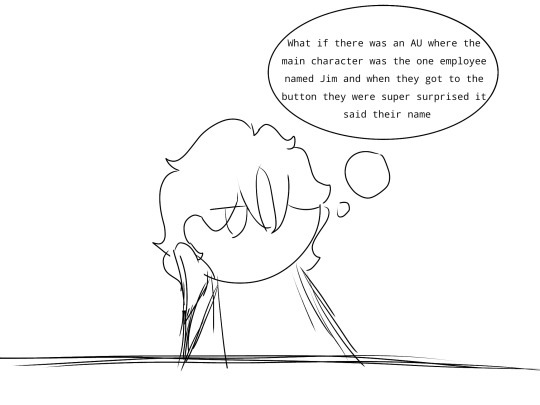
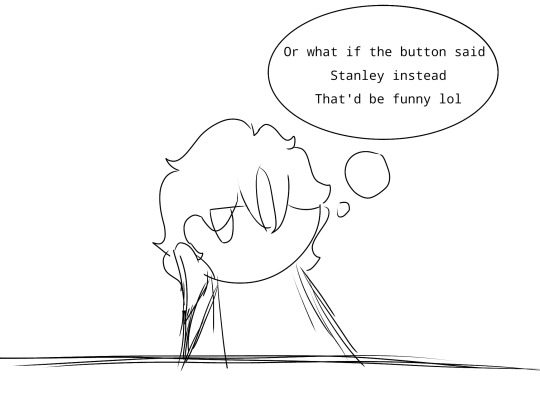

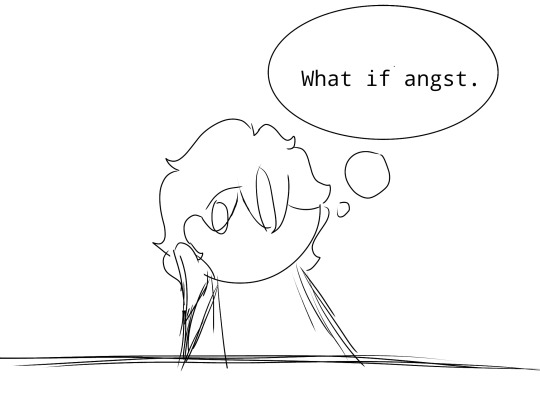
I had an idea (AU explanation below cut, a lot of yapping cause I'm excited about it)
So the premise is that the first game was "The Stanley parable", and it had all of the original endings and stuff, but in between games, Stanley escapes the parable (much to the narrators dismay) so when the ultra deluxe version came around, opening the game was greeted with the line "This is the story of a man named Jim" instead of Stanley. Jim has a whole other office and stuff (Also the path leading to office 427 is blocked off). The Narrator chose one of Stanleys coworkers to replace him when Stanley ran off, and just decided to use jim, but paths like the not Stanley ending or the zending will have the narrator break down a littleIn the not Stanley ending, the narrator will start talking about this guy named Stanley, telling Jim he has to act like Stanley, who Jim has no memory of (because the narrator wiped every mention of Stanley from everywhere in the building out of spite. He's gone from memories, reports, and his monitor in the monitor room is glitched like 234's is, and the screen will just say "no feed") back to the not Stanley ending, the narrator will end up saying stuff like "You're not him! You'll never be! You're just some cheap replacement!" But at the part where it's out of body, the narrator can be heard pleading for jim to do something like how he does in the original game, but there will be comments about how the narrator doesn't want to be alone again.
As for the zending, as Jim throws himself off the stairs, the Narrator will begin to talk about it as though it's happened before, saying stuff like "No, no, not again, please, get down from those stairs, I can't do this again!" Or "You're just as bad as he was." "Why does everyone always hate me? I just wanted to be happy, what did I do to deserve this?" There are happier endings where Stanley is mentioned, such as the broom closet ending, where the narrator would say stuff like "Oh, oh no, please leave the broom closet. He did this as well. He just sat here. For hours!" And when we get to the name button, the narrator will say something like "Since it's still in development, I decided to just make the button say Jim, since that's the name of our main-" (button)"Stanley" (narrator"….. The button wasn't supposed to say that…" Also, other characters will be aware of stuff like this, such as the timekeeper, who will try to explain the story of Stanley to Jim And in the museum ending, the curator will say stuff like "Have you seen him? Have you seen how desperate the narrator is for a friend? He had more than a friend once. But he drove that friend to try to run… Even I don't know what came after that"
I'm entirely sane, and also I thought about this while waiting for my French fries to finish cooking
#posts#art#my art#Doodles#Tsp#tspud stanley#stanley tsp#tspud#tsp stanley#tspud narrator#tspud timekeeper#tsp narrator#tsp au#tspud au#tsp curator#tsp timekeeper#The Stanley parable AU#The tag is also going to be#The Jim Parable
39 notes
·
View notes
Text
I love that the docs on php.net explain this name by saying:
Paamayim Nekudotayim would, at first, seem like a strange choice for naming a double-colon. However, while writing the Zend Engine 0.5 (which powers PHP 3), that's what the Zend team decided to call it.
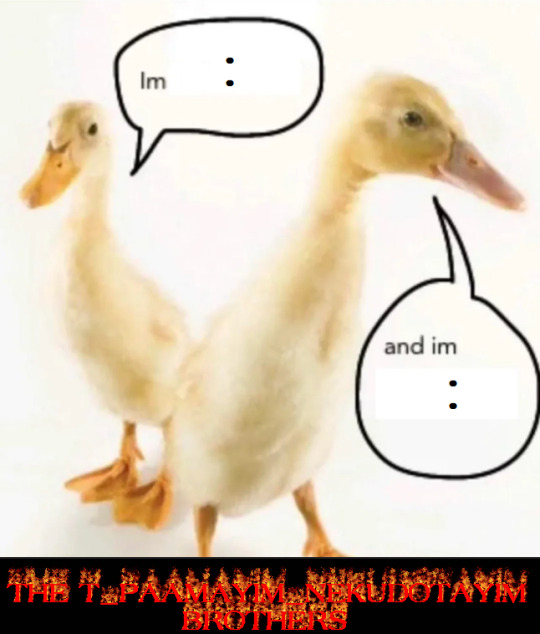
#the crucial fact missing from this explanation is that Zend Engine 0.5 was developed by a primarily Israeli team#which is why they named the operator in hebrew#this is not evident from the explanation 'the team decided to call it that.'#FOR COMPUTER SCIENCE!
6 notes
·
View notes
Text
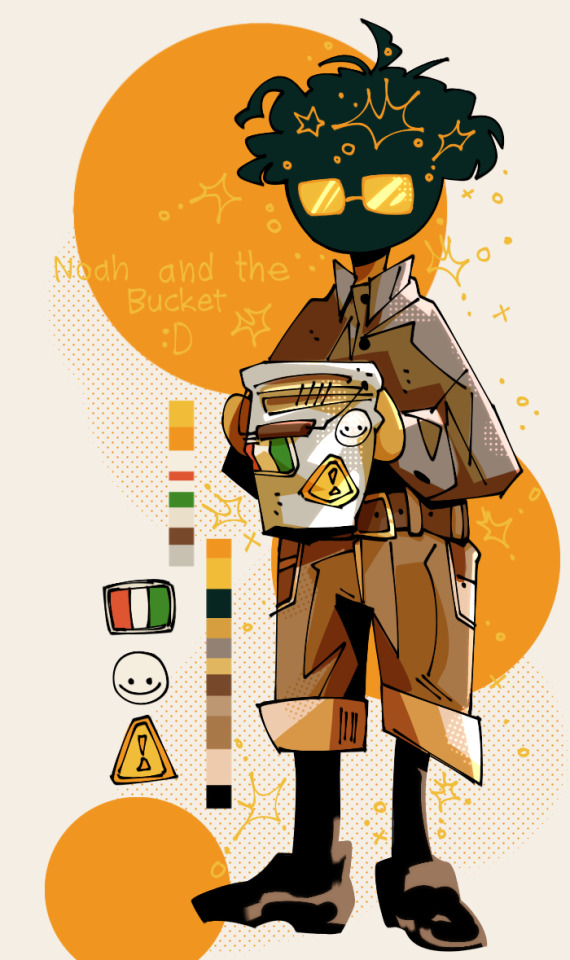

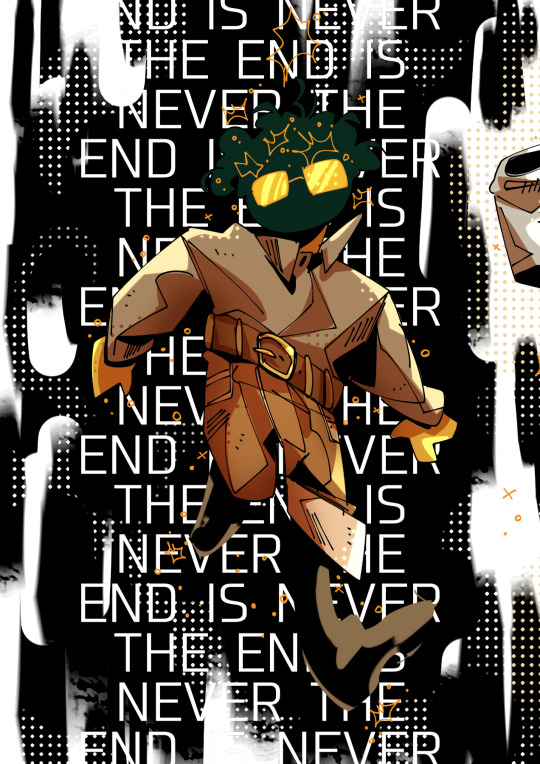
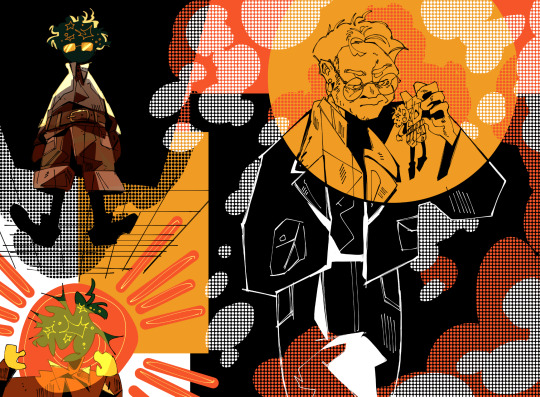
Hiii! This is my first time doing something like this, but I'm Noah (or 林武达) with the beloved bucket for @springbon-t-art "The Missing Coworkers" event :D
The favorite ending(s) that comes to mind first are endings like zending or the skip button. I just think it's really interesting when the game highlights how little authority the Narrator really has despite the role he tries to play. The whole game is how the Narrator can't make Stanley listen and just play out the story, like how there can be unreliable narrators or third person oriented or anything where the narrator isn't omnipotent. The Narrator is only as powerful as the story allows him to be, like how in the confusion ending the game can't handle the Narrator becoming independent and saying he isn't going to restart this time, so the game just automatically restarts and erases all of the Narrator's memories. The Narrator isn't even there anymore at some point in the epilogue and skip button, which could imply mortality or something to that degree. I just really like it when the Narrator becomes a character who is capable of developing despite how you're supposed to be the protagonist, but he's stuck being a passive character by virtue of the game's design.
He's just so silly to me, little British man who just wants his story to go smoothly
#the missing coworkers#tsp#tspud#AAAASIMSOEXCITED#the narrator lives in my head rent free with all the other little guys I've collected#the stanley parable#the stanley parable ultra deluxe#tsp stanley#tsp narrator#tsp bucket#art#drawing#digital art#artists on tumblr#sketchbook
222 notes
·
View notes
Note
*raises hand* hi! So! In a previous ask you said that the curator knew what she looked like cause she’s rad and that the narrator could get there with some character development but can’t cause resets. In the current bit of the story the narrator can perceive himself now after Stanley perceived him even harder then normal, so does that mean that the narrator is reset proof now, or is there a difference between the curators thing and the narrators new thing?
Apologies for the wait but I wanted to make sure I answered this properly! :D
The only difference between the Narrator & Curator’s situations is that the Narrator has more ‘bindings’ on him. The Curator was a less volatile entity & needs all her memories to do her job. Meanwhile, the memory reset acts as a sort of Leash on the Narrator. But Stanley did the impossible. What happened in the Zending Room never should have happened under the Parable’s rules. But it did. In turn, the Narrator was given a change at Real Development.
So—is he reset proof now? Well, they have no idea. Which makes things rather scary and uncertain for them, doesn’t it? We’ll have to wait & see
134 notes
·
View notes
Text

ok so William Pugh posted this in the Crowsx3 discord (supposedly, i don’t understand discord and took the image from a repost lol) and i’m obsessed with it
at first i was thinking it was just a guide for TSP, but it’s actually an early development version!!!
and i want to ramble about it
first off: the fact that the level changes in the cargo room but not after the two doors baffled me lol
second off: they list things like “Trapped In Office Bug” and “Falling out of map bug”, so if it really is an early version of the 2013 game they knew about it. or, it’s just a recreation showing we’re the UD endings came from lol
when you go right, there’s two separate times you got the chance to return to the left door rather than just one.
for the Confusion ending, it may have been a lot smaller. only one level change is shown and the Narrator personally resets the game.
the Warzone mentioned in the Museum was seemingly replace with Not-Stanley? or it was removed, and unplugging the phone was added later? my point is that the Warzone would’ve happened by the phone
also, trapped in apartment? just caught my attention
IN THE ZENDING THE NARRATOR LEARNT TO SPEAK??? WHAT DOES THAT MEAN???
was the Narrator going to attempt to understand Stanley???? instead of begging him not to mess up HIS game???? vile we need this version now
“You find the broken map” there were other images posted of the TSP office we’re used to and the 2011 HL2 version melding together, I think this is that
NOW THE LEFT DOOR YAY
you would’ve hit the lounge in the left door, like the HL2 mod, and that’s where the broom closet was!
the keypad leading to something called “The Original”? perhaps referring to the HL2 mod again??? and what are demakes???
there was a choice to escape the crusher in the museum ending, and if you don’t go into it you commit suicide? maybe this was the zending and the current one was therapy or something???
also: curator is just called “Alt. Narrator” because we made the curator up she doesn’t have a name 😭
there was the option to change your mind when you press on or off??? kinda glad they changed that one ngl
“Out Of Bounds Ending” is probably the serious table lol
this is actually so fascinating to me, to see how much changed in the two-ish years of development on the game
thank you william
8 notes
·
View notes
Note
(Zending as an ask ayyyy)
Okay so we know Wil and Gaston are ADHD...depression and anxiety are really comorbid with it. Gaston def had particularly bad depression when younger, Wil develops panic attacks.
No this isn't me projecting idk what you're talking about
It’s interesting to think of Gaston having some hard stuff he deals with that stays hidden behind his goofy and upbeat attitude. I’d imagine he’s much better nowadays, but every once in a while it comes to the surface in those quiet moments in the night where he’s alone.
It would not surprise me if Wilbur dealt with panic attacks after the events of the movie. Panic attacks suck.
#meet the robinsons#mtr#disney#gaston framagucci#uncle gaston#wilbur robinson#also I’m gonna use asks to keep the content coming in between chapters#so that way you always got something to read!
8 notes
·
View notes
Text
guess who spent an hr fleshing out the lore for my tsp universe (aka what my blog is based off of, and also narry rn)
puttin this under the cut bc its long as fuck n i dont wanna clog up your dash djehfjsjf
(this was written on the bus so im so sorry for any errors skfjs)
#########
Fourth Wall AU
Characters:
The Narrator
Player/Oswin
Stanley
The Adventure Line/Lynne
Plot:
• The Stanley Parable (2013) started off as nothing more than a video game with a basic ai Narrator repeating a script with minor changes every run.
• Eventually, the Narrator gains consciousness but keeps to the game, trapping himself in repetition as opposed to trying to escape
• He has major issues with the endings such as the zending and the confusion ending. While he knows he was purely artificial originally, he prefers to ignore it and believe he is a real being with free will.
• Aside from the Narrator, everything in the game is coded. Stanley is just a vessel for the player, all the objects don't really talk, ad everything is planned, despite what the Narrator believes.
• He remembers every reset. Though not every ending in incredible detail. Endings like the Zending, Confusion, and the Skip Button are vague memories in his head. The skip button being a time-sped up ending and becoming a blur to him that he forgets normally.
• The Narrator knows about the developers, but cannot speak to them.
• All Stanley's input is from the players. The Narrator doesn't know this and just thinks that Stanley either has terrible memory or has vastly different mood swings.
• In the Not Stanley Ending, he realises that the player isnt the Stanley he believes he knows and splits them. Leaving the Player above the two doors room.
• The Narrator, in the HD remake, cant believe that there are real people. He knows of them, but knowing that they are with him in the game will give him an existential crisis/make him distressed, and as a result, reset the game (see: confusion, zending). So the game has a feature where it wipes his memories from the Player unplugging the phone up until they split.
• Things change when Ultra Deluxe comes out.
• The game is revamped completely, The Narrator can feel how smoother the game feels, especially since its running in unity despite it looking exactly like its 2013 version on the source engine (? fact check this)
• One major change is that the Narrator can hear some players as they play the game. Given that they have a working mic and all.
• Surprisingly he doesn't mind it. Enjoying getting reactions from his script despite the fact its real people.
• Ultra Deluxe loses the feature to reset the game if the Narrator gets too upset. Instead, its a plannes forced reset.
• Eventually, he ends up with a player whom he enjoys hearing the responses to. Responding to the Narrator like they were in a conversation as the player rambles. Internally, he's scared to break the fourth wall. Afraid it might spook the player and lose this one shred of genuine connection.
• They continue like this for a while. The narrator subtly changing the delivery of his lines to better suit the players moods. In turn the player responds as usual, without noticing that the Narrators dialogue is changing.
• Its subtle. Being more harsh and boring when they hear the player talking about an exam they should be studying for and not here playing the game so they can leave and do well. Being more soft when theres that all too familiar hurt tone in their voice while they play. Being a bit more snarky when they laugh at everything he says. The player even goes to the starry dome to study, and the Narrator feels like he is hanging out with a friend, knowing that the player would never go into the other room. (They have, once. then never again)
• At some point, the Narrator slips up and responds to something the player says and as while he fears a negative reaction, he gets a surprised gasp followed by a few noises he cant place before a "Is that new Narry dialogue?! lets fucking go!"
• The narrator sighs in relief before chuckling a bit. "Language, dear player."
• The player pauses. Now there is the silence he was afraid of.
• "...Hello?"
• "Hello, Player."
• More silence.
• "This... this isnt prerecorded right? No voice recognition system in the game-?"
• "Prerecorded?! I'll have you know I do all of my voice lines live for you players, thank you." He scoffs, somewhat offended
• "Have you been listening to every players reactions this whole time?!"
• "Well not every player of the Stanley Parable. But right now its just been you that ive been hearing for the past few months."
• "Oh my god you must've heard me talk about your voice so much- im so sorry."
• He laughs, surprisingly genuine. "Nonsense! It's been a delight hearing your responses and your voice, Player-"
• "Oswin." The player says gently, "My name is Oswin, Narrator."
• "...Well, Oswin. To be perfectly honest, I adore hearing your responses to the game and to my script. You are one of the rare few who respond as though we were in conversation and truth be told, its a welcome change to the players who tell me to piss off or talk to themselves."
• They snort. "You mean the youtubers?"
• "Definitely."
• Thus starts A friendship between Oswin and the Narrator
• With this new connection, the Narrator slowly gets used to the idea of sentience and the real world. Feeling more and more human as the friendship helps him understand his world and beyond.
• He gets used to manipulating the game around him. Locking the game to be only on Oswin's computer and being able to interact with him through screens.
• While this happens, the game slowly starts to glitch. Stanley becomes sentient, going through the same dillema the Narrator had, however the Narrator is able to reassure him and help him understand.
• It takes a bit of work, considering that Stanley up until their instance of the game locked onto Oswin's PC had undergone every ending an unfathomable amount of times. With his sentience he has to process the fact that both he and the narrator were trapped in the game with no free will.
• At this time, the Narrator manages to enter the real world. With some help of coding magic and Oswin's powers alowing him to exist in the real world.
• The Adventure Line grows sentient too. However due to the fact that the Line was never fully fleshed out as a character, when it came to the real world, it turned into a teenage girl by the name of Lynne.
• Stanley also enters the real world.
The three of them are able to pop in and out of the Parable. It being treated more like their second home
#ficswin#THE LOREEEEE#tsp narrator#tsp#tspud#the stanley parable#the stanley parable ultra deluxe#stanley parable#tspud narrator#tsp stanley#tspud stanley#fourth wall au
30 notes
·
View notes
Text
PHP Development Services: Powering Scalable, Secure, and Dynamic Web Solutions
In today’s digital-first world, businesses need powerful and flexible web solutions to meet ever-evolving user demands. PHP development services offer an excellent path to build scalable, secure, and performance-driven applications. From dynamic websites to enterprise-level platforms, PHP has remained one of the most reliable server-side scripting languages powering over 70% of the world’s websites, including platforms like Facebook, WordPress, and Wikipedia.
Why Choose PHP for Web Development?
PHP (Hypertext Preprocessor) is a general-purpose scripting language designed for web development. It offers a robust set of features that makes it ideal for building custom web applications, CMS platforms, eCommerce solutions, and more.
1. Open Source & Cost-Effective
PHP is free to use and supported by a massive global community. Businesses can reduce development costs without compromising quality or scalability.
2. Highly Scalable & Flexible
Whether you're building a simple website or a complex enterprise solution, PHP provides the scalability needed to grow with your business. It easily integrates with front-end technologies and third-party APIs.
3. Fast Performance
PHP scripts are executed on the server, offering faster loading times and improved performance—especially when paired with caching tools and PHP 7+ improvements.
4. Cross-Platform Compatibility
PHP supports major operating systems including Windows, Linux, and macOS, and it works seamlessly with popular databases like MySQL, PostgreSQL, and MongoDB.
5. Secure Frameworks
With robust frameworks like Laravel, Symfony, and CodeIgniter, PHP development ensures enhanced security, rapid development cycles, and structured codebases.
Core PHP Development Services
Professional PHP development companies offer a wide array of services tailored to meet diverse business needs:
✅ Custom PHP Web Application Development
Tailored web apps built from scratch to match your unique business logic and goals, using clean, maintainable, and scalable PHP code.
✅ PHP-based CMS Development
Build or customize content management systems like WordPress, Joomla, or Drupal to enhance user experience and streamline content workflows.
✅ eCommerce Solutions
Leverage platforms like Magento, OpenCart, or custom PHP scripts to develop high-performance, secure, and feature-rich online stores.
✅ API & Third-Party Integration
Integrate your application with payment gateways, CRMs, social media platforms, or analytics tools to streamline operations and enhance functionality.
✅ PHP Migration & Upgradation
Upgrade outdated PHP applications to the latest version or migrate legacy systems to modern PHP frameworks for improved performance and security.
✅ PHP Maintenance & Support
Ensure your applications run smoothly with regular updates, bug fixing, performance tuning, and 24/7 technical support.
Industries Benefiting from PHP Development
PHP development services cater to a wide range of industries, including:
Retail & eCommerce
Healthcare & Telemedicine
Education & E-learning
Finance & FinTech
Real Estate
Logistics & Transportation
Media & Entertainment
Popular PHP Frameworks for Efficient Development
To streamline development and reduce time-to-market, PHP developers use a variety of frameworks:
Laravel – Modern, elegant, and ideal for rapid development
CodeIgniter – Lightweight and performance-optimized
Symfony – Enterprise-level framework with reusable components
Zend – Ideal for complex, enterprise-grade applications
Yii2 – Fast, secure, and great for large-scale applications
Why Hire a Professional PHP Development Company?
Partnering with a skilled PHP development agency ensures:
Access to experienced developers
Agile and transparent project management
On-time delivery and post-launch support
Customized, user-centric solutions
Scalable architecture and clean code
Final Thoughts
PHP continues to be a top choice for businesses looking for robust, cost-effective, and scalable web solutions. Whether you need a custom CMS, an eCommerce portal, or a cloud-based SaaS platform, PHP development services provide the right tools and expertise to turn your ideas into reality.
If you’re looking to build or upgrade your web platform with expert PHP developers, now is the perfect time to leverage this dynamic technology.
0 notes
Text
Top 10 Powerful Features of PHP Every Developer Should Know

PHP (Hypertext Preprocessor) has been a dominant scripting language in web development for over two decades. From small-scale websites to massive content management systems like WordPress and Drupal, PHP powers a large portion of the web. But what makes it so popular and effective? In this blog, we'll dive deep into the top 10 powerful features of PHP every developer should know.
Whether you're just starting out or looking to deepen your understanding, these features showcase why PHP continues to be a go-to choice for server-side development.
1. Open Source and Free
One of the most appealing features of PHP is that it’s completely free and open-source. Developers can download, install, and use PHP without paying licensing fees. Moreover, being open-source means it has a large and active community contributing to its ongoing development and support.
Why it matters: This accessibility makes PHP a great starting point for students, freelancers, and startups looking to build dynamic websites without high initial costs.
2. Platform Independent
PHP is platform-independent, meaning it can run on any operating system—Windows, Linux, macOS, or Unix. This flexibility allows developers to deploy PHP applications across different environments without major code changes.
Why it matters: Platform independence ensures easy integration with existing systems and hosting environments.
3. Simple and Easy to Learn
PHP is known for its straightforward syntax, which closely resembles C and Java. This makes it easy for developers with programming experience to pick it up quickly. Even beginners find PHP approachable due to its readable code structure and supportive documentation.
Why it matters: A short learning curve means developers can quickly start building real-world applications.
4. Supports Database Integration
PHP seamlessly connects with various databases like MySQL, PostgreSQL, MongoDB, Oracle, and more. With built-in functions like mysqli_connect() and support for PDO (PHP Data Objects), managing data is fast and secure.
Why it matters: Efficient database connectivity is crucial for building data-driven applications such as blogs, e-commerce platforms, and CRMs.
5. Extensive Library of Built-in Functions
PHP provides a vast set of built-in functions that allow developers to perform a wide range of tasks—string manipulation, file handling, form validation, session control, and much more—without the need for third-party libraries.
Why it matters: Built-in functions speed up development and reduce reliance on external code, leading to cleaner and more maintainable applications.
6. Strong Community Support
With millions of developers using PHP globally, there’s a massive community behind it. You’ll find plenty of resources, tutorials, forums, Stack Overflow threads, and open-source tools available at your fingertips.
Why it matters: A strong community means fast troubleshooting, regular updates, and ongoing evolution of the language.
7. Powerful Frameworks
PHP boasts several powerful frameworks such as Laravel, Symfony, CodeIgniter, Zend, and Yii. These frameworks follow the MVC (Model-View-Controller) architecture and offer built-in tools for routing, authentication, and templating.
Why it matters: Frameworks enhance productivity, enforce coding standards, and help developers build scalable and secure applications faster.
8. Robust Security Features
PHP includes various security mechanisms to help developers build secure applications. Features like data encryption, input validation, and built-in support for session handling protect against common threats like SQL injection, XSS (Cross-Site Scripting), and CSRF (Cross-Site Request Forgery).
Why it matters: Security is critical in web development, and PHP provides the tools necessary to safeguard your applications.
9. Efficient Performance and Scalability
PHP scripts are executed on the server, and thanks to its efficient memory usage and processing speed, PHP delivers quick load times. It’s also scalable—Facebook’s early version was built on PHP, showing its capacity to handle massive user bases.
Why it matters: Performance and scalability ensure PHP applications can grow with your business or user demands.
10. Integration with Other Technologies
PHP integrates smoothly with a wide range of technologies—HTML, CSS, JavaScript, XML, JSON, REST APIs, and more. It also works well with third-party services like payment gateways, cloud storage, and analytics tools.
Why it matters: Seamless integration enables developers to build feature-rich, modern web applications that meet current tech standards.
Conclusion
These top 10 powerful features of PHP highlight why the language remains a dominant force in web development. Its simplicity, flexibility, and extensive support system make it a smart choice for developers across all experience levels.
Whether you're building a small personal blog or a high-traffic e-commerce site, PHP has the features, tools, and scalability to support your goals. Learning PHP not only opens doors to freelance and full-time development opportunities but also provides a solid foundation for backend development in general.
So, if you haven’t explored PHP yet or only know the basics, now is the perfect time to dive deeper and unlock its full potential!
Keyword Focus: Top 10 Powerful Features of PHP Every Developer Should Know, features of PHP, why use PHP, PHP for web development.
0 notes
Text
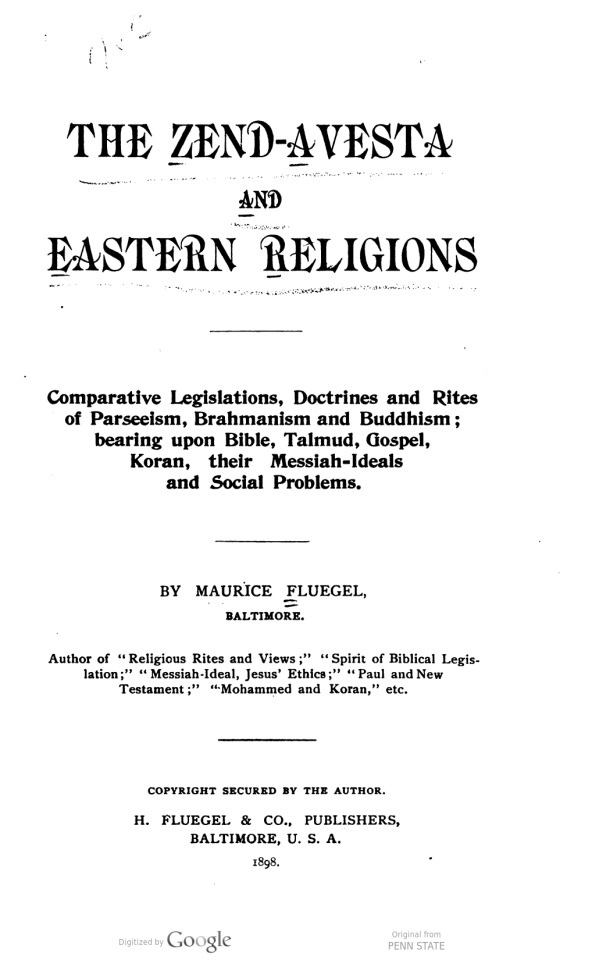
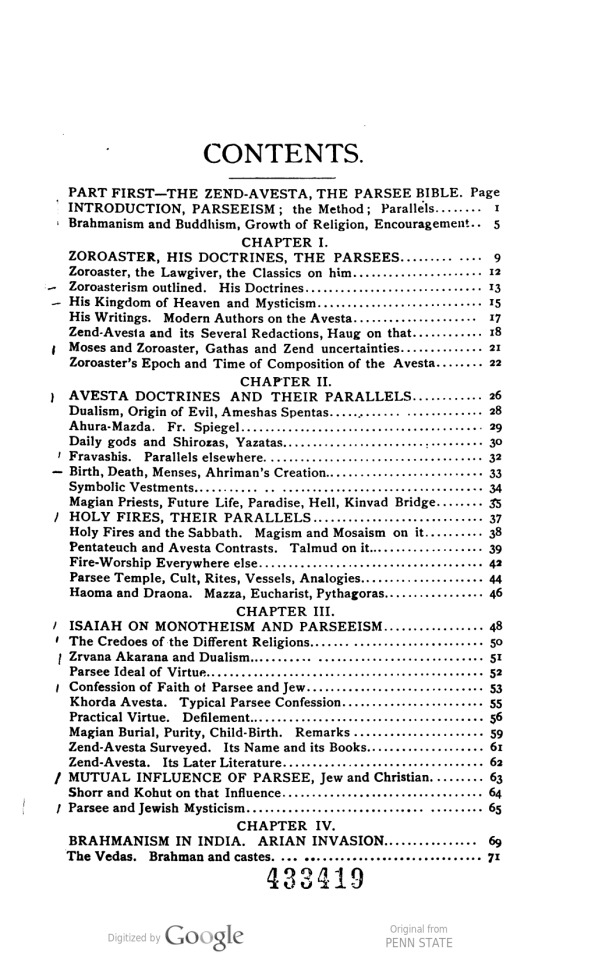
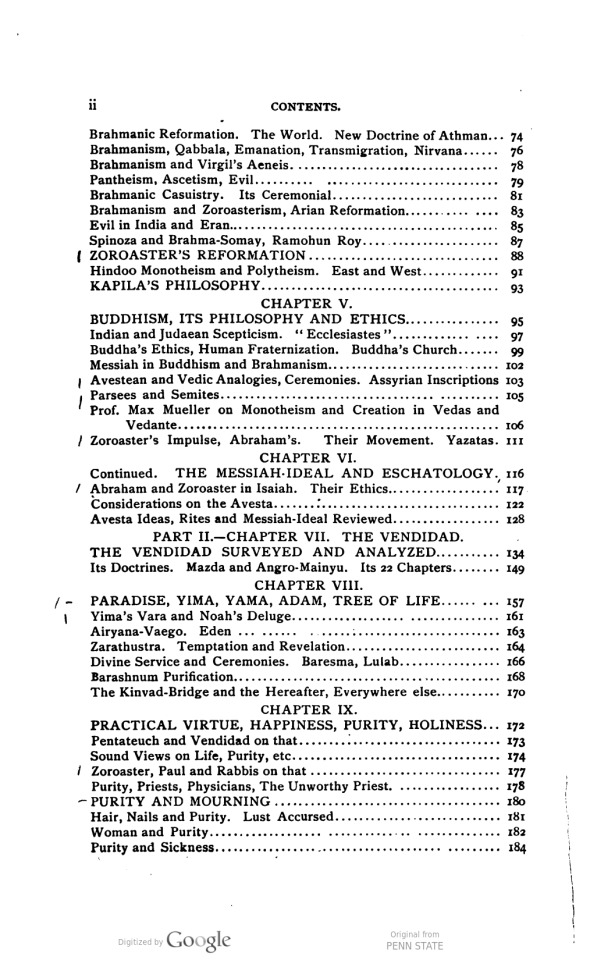
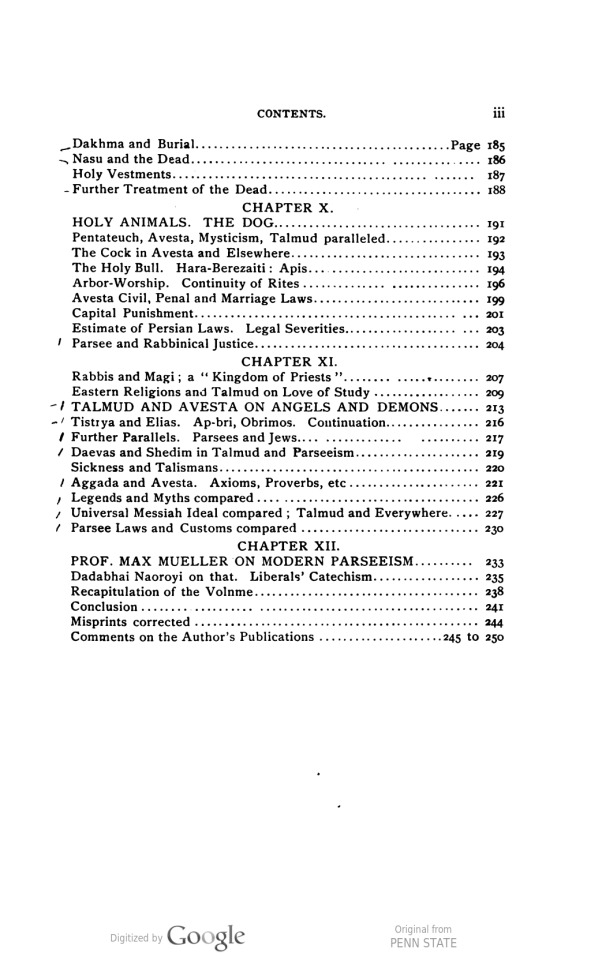
THE ZEND-AVESTA. INTRODUCTION. Having treated in the preceding volumes of this series of the doctrines and legislations of the three great Western religions, Judaism, Christianity and Islam, we have now arrived at the dis- cussion of the Eastern Religions, those of Iran, India, Ceylon, China, Japan, etc. These are Parseeism, Brahmanism and Budd- hism. We shall treat here especially of Parseeism. The important doctrines, the social scheme and legislation of Eran or Iran, the bible of Zoroaster, the Lend-Avesta is the leading theme of this volume. Brahmanism and Buddhism, the religions of the Hindoos, Chinese, Birmans, etc., will be discussed as important corollaries. The bearing and influence of these Eastern systems upon the West- ern ones is the object of this study. To find out their relation to- wards one another, what affinities and what discrepancies, what analogies and what contrasts, what gain or loss, advance or retro- gression, these two leading religious sets exhibit towards each other, to find out the different phases of each of these groups and of every member of the group, how they represent but one continued chain of development, one ethical and social growth of the "Tree of life and of knowledge," termed religion, connecting all the races, creeds and systems into one unit of civilization and humanization-that is the final scope of this volume; devoted principally to the study of the Zend-Avesta with its relation to and bearing upon the Western biblical religions. Parseeism. In far-away Hindustan, in the capital of British India, the magnificent and powerful commercial emporium of Bom- bay and its vicinity, there live among the native Hindoo and Mo- hammedan populations, the remnants of an ancient people, appar- ently of a bodily and mental type different from its neighbors. Though colonized there for many centuries, they nevertheless are not absorbed by, nor even amalgamated with the genuine natives, by whom they are outnumbered as ten thousand to one. They per- tinaciously cling to their own creed, nationality and ancient tongue; to their own sacred books, laws, manners and customs. They form a distinct race and a sect. Debris of that same nationality, creed and
The Zend-Avesta and eastern religions : comparative legislations, doctrines, and rites of Parseeism, Brahmanism, and Buddhism; bearing upon Bible, Talmud, Gospel, Koran, their Messiah-ideals and social problems / By Maurice Fluegel ...
Description
Tools
Cite thisExport citation fileMain AuthorFluegel, Maurice, 1831?-1911.Language(s)English PublishedBaltimore : H. Fluegel & co., 1898. SubjectsAvesta. Brahmanism. Buddhism. Parsees. Asia > Asia / Religion. Physical Descriptioniii, 244 p. ; 24 cm.
0 notes